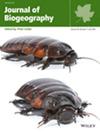Effect of Soil Properties on Species Richness of Fossorial Squamate Reptiles
Abstract
Aim
Species richness varies greatly over geographic gradients. Climate and other above-ground attributes are the most common variables used to explain animal richness patterns. However, soil properties may play an important role in shaping the richness of species living underground. Studies have yet to comprehensively analyse fossorial squamates' richness patterns and how soil properties influence them. We investigated how different predictors, including soil properties and climate, influenced the species richness of fully-fossorial, semi-fossorial, and non-fossorial squamates.
Location
Global.
Taxon
Reptilia: Squamata.
Methods
We categorised squamates into fully-fossorial, semi-fossorial, and non-fossorial, and assessed species richness for each category independently. We selected potential soil and climatic factors that could influence their richness. Then we used ordinary least squares regression models with spatially lagged variables (OLSL) and geographically weighted regression models with spatially lagged variables (GWRL) to investigate the influence of soil properties and climate on the species richness of each group.
Results
Fully-fossorial squamate richness peaks in Africa and South America. Semi-fossorial squamate richness is highest in South America and Australia. Non-fossorial squamates exhibit maximum species richness in South America and Southeast Asia. Species richness was more strongly associated with climate than soil properties in all groups. Nevertheless, as the levels of fossoriality increase, soil properties become more important correlates of species richness of squamates.
Main Conclusions
This study highlights the importance of incorporating soil factors alongside climate in the study of fossorial animal biogeography.


 求助内容:
求助内容: 应助结果提醒方式:
应助结果提醒方式:


